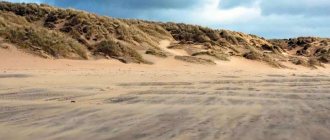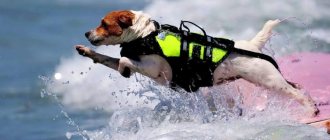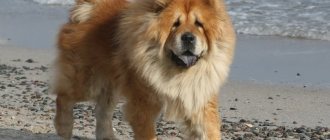The name of the island of Newfoundland means “newly discovered land” in English. It is located in the North Atlantic, off the east coast of Canada. The narrow Strait of Belle Ile separates it from the southern edge of the Labrador Peninsula, in the East Newfoundland is washed by the Atlantic Ocean, in the West by the Gulf of St. Lawrence. The ancestors of the Indians began to populate it back in the 1st century, and the Europeans began ten years after the discovery of America by Columbus. But neither one nor the other were able to conquer it, and the island has still retained its wild, pristine appearance, having ceded only a small part of its vast territories to people.
First Europeans
There is historical evidence confirming that the island of Newfoundland was visited by Norman Vikings as early as the 11th century. Historians believe that the Icelandic sagas call it Vinland, and the Labrador Peninsula - Markland. Folklore may embellish the reality, but on the island of Newfoundland there are remains of a Norman village, which are a local landmark and are protected by UNESCO as the first European settlement in the Western Hemisphere.
Even in those distant times, this place was not deserted: the ancestors of the Indians and Eskimos lived here, with whom the Vikings traded, giving little thought to geographical discoveries. This fever began later.
Relief
The island is characterized by mountainous and hilly landscapes. The average height on its territory is 400-600 meters. It is a continuation of the Appalachian mountain range. The highest point on the island of Newfoundland is Cabox Peak, which rises to 814 meters. It is located on the Long Range ridge in the western region of the island.
In the western part, the mountain plateau of the island turns into coastal lowlands, but mostly ends with steep cliffs. The eastern and northeastern shores of Newfoundland are rugged with rocks. In the waters next to it there are several hills called banks. Their total area is almost equal to the island itself.
On the southeast side is the Great Bank of Newfoundland. It is a huge shelf. In its area the water depth does not exceed one hundred meters. The bank is located at the intersection of cold and warm currents, which brings fog to the island.
The Age of Great Travels
It would not be wrong to say that the island of Newfoundland and the coast of the Labrador peninsula revealed the invincible spirit of selfish European curiosity. In the second half of the 15th century, a fashion arose among the powerful powers of the current EU to travel to India through the Western Hemisphere. The well-known Columbus was the first to go in search and stumbled upon a new continent - the Spaniards found the richest colonies.
Having learned about such unheard-of successes, the Bristol merchants decided to equip their own expedition - the hope of reaching blessed lands full of gold and precious spices was still intoxicating many heads. Since it was not possible to receive any support from the state, except for the blessing of the English king Henry VII, the enterprise could not boast of a wide scope.
Discovery of Newfoundland
In May 1497, a ship sailed from the Bristol pier under the command of the English navigator of Italian origin John Cabot (Giovanni Caboto), who, by and large, opened the island of Newfoundland to Europeans. The ship was called "Matthew", and there were only 18 crew members on board - apparently, the organizers did not count on rich booty, and the purpose of the expedition was only to reconnaissance of the area. After spending just over a month on the ocean, Cabot reached the northern coast of Newfoundland in June 1497. Having set foot on the land and declaring it the possessions of the English crown, the traveler went further along the coast, opened the Great Newfoundland Bank, rich in fish, “wandered” around the island for a month, turned back and arrived in England on August 6.
The information Cabot brought was not at all encouraging: gloomy, cold, there was nothing but fish. It must be said that the reports of travelers of those years are shrouded in the darkness of mystery - no one wanted to share information, fearing the machinations of competitors. Therefore, the remaining evidence is extremely scarce. Whether John Cabot reached Labrador or not is not known for certain.
Newfoundland Island on the map
Considering the size of North America, finding tiny Newfoundland on the map is a task for a true geography fan. And even for him, coping with the task is not always easy. Therefore, it is worth giving a more clear illustration.
North America
If we consider the mainland of North America, then finding an island will not be so difficult. Just look at the easternmost part.
Mira
But coping with the same task, having only a map of the world in hand, is much more difficult. As is understandable, the area of the island is a little more than 111 thousand square kilometers.
The small piece of land located inside the red frame is the desired Newfoundland.
Territorial disputes
In this matter, the British outdid the Portuguese: the peninsula got its name from Hoyoyo Fernandez Lavrador (“lavradore” - from Portuguese landowner). In 1501, his compatriots led by Gaspar Cortereal arrived in Newfoundland. A monument to this navigator still stands in one of the squares of St. John's, the administrative center of the province (in 1965, the statue was donated by the Portuguese, nostalgic for their great maritime past).
For a long time, no one seriously claimed the territory of the island of Newfoundland; it was inhabited by indigenous tribes of Indians and Eskimos, as well as visiting Portuguese, French, Irish and English. They traded with the locals, exchanging valuable skins of beavers, otters and other fur-bearing animals with them, and were engaged in fishing and hunting.
At the end of the 16th century, the French hunted whales and fished in the southwest, and the British were engaged in trade in the Northeast. The ownership of the island was weakly contested by various European states.
Hotels, hotels, prices
on the small Canadian island of Fogo off the northeast coast of Newfoundland. The hotel was built by local architect Todd Saunders and blends seamlessly into the island's rocky landscape. The hotel offers 29 guestrooms designed by renowned designers and Newfoundland artisans. Textiles - bedspreads, curtains, etc. - are handmade by local craftswomen, and the furniture is made by boatmen, Travel+Leisure reports. The hotel has a restaurant where guests can get acquainted with local cuisine. Guidebooks have also been compiled for guests, from which they can glean a lot of useful information about the nature of the island and the whale population. Accommodation at Fogo Island Inn will cost from $550 per double room per night.
Possessions of the British Crown
In 1701, the Spanish king died - the last of the Habsburg dynasty. The War of the Spanish Succession broke out in Europe and lasted for 13 long years. In 1713, under the terms of the Peace of Utrecht, Newfoundland went to Great Britain.
However, this was not the end: during the Seven Years' War (1756-1763), France, Spain and Britain again began to dispute each other's territory, and in 1762, an Anglo-French battle took place near St. John's, in which the British won, which finally secured their rights.
How to get there
AIRPLANE
Tourists usually get to Canada by flying by plane. The largest airports are in the cities of Vancouver, Toronto, Montreal and Halifax.
Russian airlines operate flights from Moscow to Toronto (travel time is about 10 hours). With a transfer, you can fly to Canadian cities using various European airlines, not only from Moscow, but also from Russian regions.
Residents of the CIS can get to Canada using the same European airlines flying from Minsk, Kyiv, Astana, Yerevan and Tbilisi with transfers in European cities. From Kazakhstan, Air Astana flies to many European capitals, where you can connect with European airlines to Toronto, Ottawa, Vancouver and other Canadian cities.
Flights to Canada with a transfer to the USA are also possible, but you will need a US transit visa (even if you do not plan to leave the transit zone of an American airport).
You can view tickets to Canadian cities using the form below; you only need to enter the departure city, arrival city, dates and number of people - the system will offer you possible options from which you will only have to choose the one that suits you in terms of price or number of transfers.
Claims of the Canadian Confederation
Canada made attempts to lure the island into the sphere of its political and economic influence, but Newfoundland was not particularly enthusiastic about this. In 1869, the proposal to join the Canadian Confederation was flatly rejected. After, by order of London, the Labrador Peninsula was annexed to Newfoundland, Canada offered assistance in developing local iron deposits and was again refused: the islanders rightly believed that, having become economically dependent on the confederation, they would inevitably lose sovereignty. However, what will happen cannot be avoided.
In the 30s, a global crisis broke out, which led to the collapse of the economy of the island of Newfoundland. London introduced “external administration”, and a special commission was created to determine the future fate of the island. After the end of World War II, the decision was made and implemented. In 1948, following a referendum, the island of Newfoundland became one of the provinces of Canada, which it remains to this day.
Newfoundland Health and Diseases
Newfoundlands are characterized by a number of diseases, both common to all dogs and specific to this breed. Their massiveness creates problems for the musculoskeletal system; they often develop arthritis and hip dysplasia. A sedentary lifestyle and lack of activity can lead to obesity and, as a result, heart disease.
A native of the north, the Newfoundland suffers from the heat and may well suffer from heatstroke. Its main symptoms are lethargy, a dry, warm nose, and lack of appetite. On hot days, you need to make sure that your dog always has water in his bowl. Under no circumstances should you leave your dog in a closed car. In summer, it is advisable to provide the diver with the opportunity to swim more often.
Population and climate
Today the population of these places is about 500 thousand people. Considering that the island's area is about 111.39 thousand square kilometers, the population is more than modest. The settlements are mainly located on the coast, since fishing has long been the main means of subsistence for local residents.
Cool dampness had long ago claimed the island of Newfoundland, whose climate was considered “terrible” even by the British.
In the summer in the Southeast, the temperature does not exceed 15°C, but the proximity of the Atlantic causes fairly warm winters - it rarely gets colder than -4°C. In the North-West, the temperature regime is sharper: in summer it reaches 25°C, and in winter there are ten-degree frosts.
The topography of different parts of Newfoundland also differs. In the West, the terrain is mountainous; the local Long Range is considered part of the Appalachians (the island once broke away from the prehistoric mainland as a result of a terrible geological cataclysm). Where the island of Newfoundland is located, the warm waters of the Gulf Stream meet the cold Labrador Current. This results in significant rainfall on the island (75-1500 mm). Due to the collision of water and air currents of different temperatures, white fluffy clouds occupy the island of Newfoundland for almost a third of the year. Photos of the swirling haze, through which the rooftops of St. John's can be seen, are surprisingly reminiscent of scenes from Stephen King's The Fog.
History of the island
Of course, speaking about Newfoundland, we should touch on such an important topic as its history. Moreover, it is advisable to do this in detail, tracing the incidents from the time of discovery to the present day.
Who discovered the island of Newfoundland
It is impossible to answer this question unambiguously. Officially, the laurels of the discoverer belong to Giovanni Caboto, an Italian-English navigator. He was looking for an opportunity to sail to India through the northwest and as a result discovered this island. He named it Terra Prima Vista, which translates from Italian as “The first land seen.”
Three years later, in 1500, the island was rediscovered. This time the Corte Real brothers from Portugal stumbled upon him. They gave it the name "Land of the Cortirials".
But even before that, the island was “opened” and populated, more than once. For example, back in 8-4 millennia BC, primitive tribes settled here, who were displaced by Paleo-Eskimos from 30 to 6 centuries BC. Their descendants lived here until the nineteenth century, but gradually died out due to epidemics and incest.
Thanks to archaeological finds, it was possible to establish that Vikings settled here already in the eleventh century. Perhaps these lands were called Vinland by people from the harsh northern countries. This happened in the tenth century AD - during the voyage of Leif Eriksson, the Vikings found the island and tried to colonize it. But due to the remoteness from Greenland and Iceland, it was never possible to settle it normally - the population of two small settlements either died out or was destroyed by the Indians.
Therefore, the name Newfoundland is a great fit for this island. After all, the literal translation of the toponym “Newfoundland” sounds like “new open land.” Different people in different eras discovered this land and believed that it was new and unknown to anyone.
Dominion of Newfoundland
For a considerable part of its history, the island belonged to Britain. Moreover, the creation of the great British Empire began with him. Back in 1583, the English military navigator Humphrey Gilbert announced that the island now belonged to England. It became the country's first overseas possession. Subsequently, other European states tried to conquer it: France, Spain, Portugal. Newfoundland not only had an advantageous strategic position, protecting the route into the interior of the North American continent. Fish were also abundant in these waters. Only in 1713 was the Treaty of Utrecht signed, under the terms of which the rights to the island were assigned to Britain. True, half a century later France captured the island (the Seven Years' War was going on), but England quickly regained control over it.
However, nothing lasts forever, not even the British Empire, on which the sun never sets. In 1907, it was decided to change the status of the island. From now on, it was no longer a colony, but a dominion, nevertheless part of the kingdom. In 1934, the Great Depression loomed over all of North America. Times were hard. Newfoundland's economy literally collapsed. As a result, the government turned to the English authorities, asking to deprive the island of dominion status and re-recognize it as a colony.
Newfoundland acquired its final status at the end of March 1949. A referendum was held on the island, as a result of which it became part of Canada, adding to the province of Labrador.
Local inhabitants
King's monsters, fortunately, are not found on the island. But there are quite terrestrial animals living, thriving due to the fact that this province of Canada has by far been the least affected by industrialization. Most of the island of Newfoundland is covered with pristine taiga, and large areas are swampy. There are moose, bears, lynxes, raccoons, foxes and many other animals here. The coastline, indented by numerous fiords and rocky bays, is a real paradise for birds and marine mammals.
Tourism
The opportunity to walk through places untouched by man attracts many fans of ecotourism. In Gros Morne National Park they find an abundance of wild coastal rocks, the beauty of clear mountain lakes and wild rapids rivers. From the steep banks you can admire drifting icebergs and migrating blue whales.
Tourists can enjoy an ancient Viking settlement, the oldest city street in North America (Water Street), museums, restaurants and souvenir shops.
Fans of sport fishing also come here: the local waters are still teeming with fish, despite the fact that they have been actively caught on an industrial scale almost since the discovery of the island of Newfoundland and Labrador. Irresponsible attitude towards natural treasures almost destroyed this land.
Care and maintenance
Newfoundlands feel great both in nature and in urban environments: they are not afraid of either busy streets or traffic. Small-sized apartments are not the best place to live for these giants, but medium-sized housing is quite suitable for them, because dogs with a calm disposition do not have the habit of rushing around the apartment, sweeping away everything around them. A Newfoundland should have its own place in the house where it can sleep or just relax. It is desirable that it be spacious and have an orthopedic base, for example, it could be a small mattress. It should be covered with a cloth that can be easily washed, as these dogs salivate profusely.
Newfoundlands are not known for their playfulness and tend to spend their time passively, but they need physical exercise. These dogs should be walked at least twice a day, preferably in the morning and evening.
The ideal place to keep a Newfoundland is a country house, near which there is a pond, lake or river. Keeping an enclosure is not suitable for a diver - deprived of communication with people, he will be sad. Moreover, you can’t put him on a chain.
Newfoundland wool requires systematic care
The Newfoundland's thick coat requires systematic care. You should brush your dog at least three times a week with a stiff brush, otherwise its fur will mat and form tangles that can make your dog’s life miserable by causing itching. If a tangle has already formed, it is better to untangle it. They are cut out in extreme, completely neglected cases. Twice a year, in autumn and spring, Newfoundlands' undercoat is renewed. During this period, the dog needs to be brushed every day. To help your pet, you can also contact a groomer who will give you an easier haircut.
Newfoundlands do not require frequent baths because their coat, impregnated with natural lubricants, repels dirt and water. The use of shampoos has a very bad effect on the condition of the coat.
Newfoundland's nails need to be trimmed once a month. It is necessary to monitor the ears and eyes, systematically checking them for the presence of discharge that may indicate infectious diseases. Periodically, ears and eyes should be wiped with a damp cloth.
Feeding Newfoundlands should be taken seriously. It should be balanced, plentiful, but in moderation, since these dogs are prone to obesity.
When feeding naturally, the dog’s diet should contain the following products:
Ooh, that's bacon
- veal, beef, lamb, rabbit (50% of the total number of products). It is not recommended to feed them pork and poultry meat;
- from cereals - rolled oats and buckwheat, and it is better to exclude rice, pearl barley, millet;
- sea fish - raw or boiled, river fish - exclusively boiled;
- cottage cheese;
- carrots, in small quantities – beets and cabbage, scalded parsley, nettle, dill, lettuce;
- bread in the form of crackers.
Potatoes, spicy and smoked foods, sweets, especially chocolate, are prohibited in the food.
The Newfoundland diet can include ready-made, high-quality super-premium and holistic food.
Puppies should be fed 5 times a day; as they get older, the number of feedings decreases. For adult dogs, it is enough to give food twice a day.
Who is this little guy here?
Sorry…
"Fish place"
The Great Newfoundland Bank is a sandbank with an area of 282.5 thousand square meters. km, which is still the richest fish deposit in the world. Uncontrolled fishing continued for centuries: in the 19th century, the population of the island of Newfoundland grew from 19 to 220 thousand thanks to settlers who dreamed of making money from fishing and whaling.
Environmentalists began sounding the alarm back in the 1970s, but the Canadian government took harsh measures only in 1992 and introduced a moratorium on fishing. By this time, fishing trawlers from almost all European countries were hunting cod in distress. The moratorium has hit the economy and the well-being of the population hard. In a short time, more than 60 thousand people left the island.
I had to find other means to earn money. Mining has intensified: the island has iron, copper and zinc ore. Oil is being extracted offshore, pulp mills have opened, and tourism is developing at a good pace. Since 2006, the population began to grow again, indicating the recovery of the local economy.
From Newfoundland - with love
The first thing that comes to mind when Newfoundland is mentioned is not the island with all its beauties, but large, good-natured dogs, whose homeland is rightfully considered to be this inhospitable land. It is not known for certain where they came from. According to one version, the breed appeared as a result of crossing Norman dogs with Indian dogs. According to another, the animals were brought by Europeans, and in the isolated conditions of the island a breed appeared, representatives of which are sometimes called divers. According to local legend, the black shaggy dog is the result of a love affair between a dog and an otter. This is why Newfoundlands are excellent swimmers, divers, and have water-repellent coats and the famous “otter tail.”
Some dog handlers, however, claim that there were originally two breeds on the island. The first is powerful black dogs, practically no different from the modern Newfoundland. They were harnessed to small two-wheeled carts, and they served as a kind of vehicle. Another breed, St. John's - the legendary "water dogs" who swam for hours without knowing fatigue, helped fishermen pull out nets and brought hunters the prey they had shot. It is believed that these dogs are the ancestors of the retrievers that are popular today.
One way or another, the gift of the island of Newfoundland to humanity is more valuable than the diamonds of South Africa or the gold of the Klondike. Is it possible to compare soulless stones or metal with a cheerful and flexible friend who has been faithfully serving man for so many years?
Education and training
Obedient Newfoundland
The Newfoundland's intelligence and excellent memory make ordinary training an enjoyable pastime. The dog grasps everything on the fly and often, without listening to the end of the task, begins to complete it. Commands to this dog should be given in a calm tone, without raising your voice. She simply will not respond to demanding orders and shouts. Actually, this is not required: it is enough for a Newfoundland to ask for anything politely and gently, and he will readily respond to any wish.











